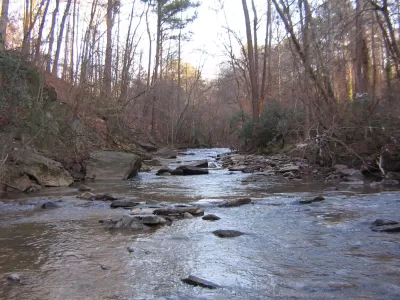The bonds finance new green infrastructure projects that otherwise would be considered too risky.

Atlanta wants to clean up the Proctor Creek watershed, and it has released a $14 million environmental impact bond for a series of green infrastructure projects, writes Jared Brey:
Environmental impact bonds (EIBs), like social impact bonds, are a type of financing that provides different levels of return for investors based on how well the projects funded by the bond perform. If a green infrastructure intervention is more effective than expected, investors get a greater return; if less successful, the return is lower.
EIBs are useful financing mechanisms for projects that are innovative but also considered risky and that might be harder to fund through a traditional bond. The Atlanta EIB will fund six projects, including installation of stormwater planters, creek and habitat restoration, and development of bioretention and wetland areas.
The firm Quantified Ventures helped Atlanta with the EIB, and it also worked with DC Water on the country’s first EIB, launched in 2016. Brey reports that investors in Atlanta include both firms committed to the environmental outcomes and larger, more traditional investment firms.
FULL STORY: Atlanta Issues Environmental Impact Bond for Green Infrastructure

Trump Administration Could Effectively End Housing Voucher Program
Federal officials are eyeing major cuts to the Section 8 program that helps millions of low-income households pay rent.

Planetizen Federal Action Tracker
A weekly monitor of how Trump’s orders and actions are impacting planners and planning in America.

Ken Jennings Launches Transit Web Series
The Jeopardy champ wants you to ride public transit.

Crime Continues to Drop on Philly, San Francisco Transit Systems
SEPTA and BART both saw significant declines in violent crime in the first quarter of 2025.

How South LA Green Spaces Power Community Health and Hope
Green spaces like South L.A. Wetlands Park are helping South Los Angeles residents promote healthy lifestyles, build community, and advocate for improvements that reflect local needs in historically underserved neighborhoods.

Sacramento Plans ‘Quick-Build’ Road Safety Projects
The city wants to accelerate small-scale safety improvements that use low-cost equipment to make an impact at dangerous intersections.
Urban Design for Planners 1: Software Tools
This six-course series explores essential urban design concepts using open source software and equips planners with the tools they need to participate fully in the urban design process.
Planning for Universal Design
Learn the tools for implementing Universal Design in planning regulations.
Heyer Gruel & Associates PA
Ada County Highway District
Institute for Housing and Urban Development Studies (IHS)
City of Grandview
Harvard GSD Executive Education
Toledo-Lucas County Plan Commissions
Salt Lake City
NYU Wagner Graduate School of Public Service




























